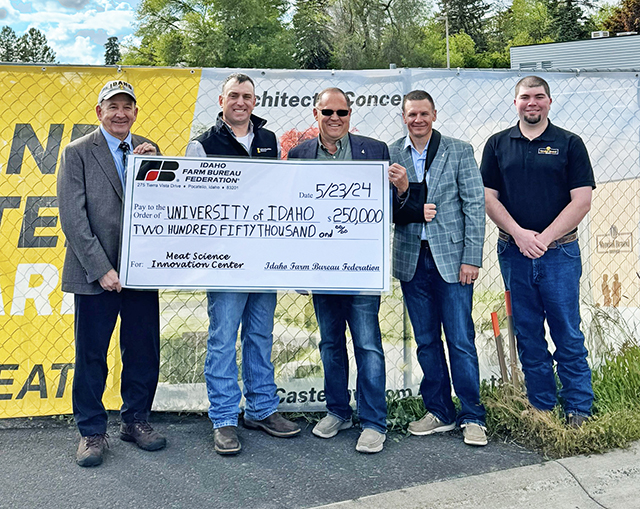Idaho Farm Bureau to donate $250,000 toward UI's new meat science facility
Idaho Farm Bureau Federation will donate $250,000 toward University of Idaho’s new $14 million meat science facility. The new 12,750-square-foot facility on U of I’s Moscow campus will be four times the size of the current meat science facility, which houses the university’s meat science program and was built in the 1960s. Groundbreaking on the project began last fall and it is expected to be completed in fall 2025. The IFBF board of directors voted to support the project with a $250,000 donation. IFBF is the state’s largest general farming organization and represents more than 10,000 people in Idaho who are involved in agriculture. IFBF President Bryan Searle, who farms in the Shelley area, said the organization appreciates the university’s vision to update the facility into what will be a major asset to the state’s cattle industry into the future. “It’s a privilege for us to be by their side to see this project through because we believe it will be a big part of the industry’s success,” he said. “We applaud all that the university is doing on behalf of agriculture.” There are currently more cows – about 2.5 million – than people in Idaho. Cattle and calves is Idaho’s No. 2 agricultural industry in terms of total farm-gate revenue and cattle producers in the state brought in an estimated $2.3 billion in revenue in 2022. The new building will be called the Meat Science and Innovation Center Honoring Ron Richard in honor of the man who is credited with building the program into what it is today. The new facility, like the existing one, will be USDA-inspected and will be a modern meat processing facility designed to allow teaching, research, outreach, service and production to occur simultaneously. Livestock producers in the region can have their animals processed there under USDA inspection, allowing them to direct-market their products, and employees from all segments of the meat supply chain will train there. "We’re thrilled by this generous gift from the Idaho Farm Bureau Federation, and we recognize we’re positioned to be operating in our new, state-of-the-art abattoir by the fall of 2025 thanks to the generosity of numerous stakeholders,” said Michael Parrella, dean of U of I’s College of Agricultural and Life Sciences, which oversees the university’s meat science program. “New meat processing plants requiring trained staff at many levels have been opening throughout the state, and the new Meat Science and Innovation Center Honoring Ron Richard will enable our college to expand upon teaching programs, research, public outreach and workforce development to meet industry needs." The new facility will benefit the state’s cattle producers and help the industry be more efficient and innovative into the future, said IFBF CEO Zak Miller. “One of the things our Farm Bureau leaders are always looking for is, how can we support our community and help our producers be more successful,” he said. “Supporting this facility is a natural way to support the university while at the same time support our cattle producers.” Miller toured the current facility recently with other Farm Bureau leaders and said he was very impressed with the ingenuity of the people who work in the university’s meat science program. With the new facility and modern technology, he said, “I really think they’ll find innovative and revolutionary ways for Idaho cattle producers to better utilize these animals we have stewardship over.” 
Idaho Farm Bureau Federation leaders present a $250,000 check to University of Idaho officials May 23 to be used to help fund the university’s new 12,750-square-foot meat science facility. From left to right: Michael Parrella, dean of U of I’s College of Agricultural and Life Sciences, Phil Bass, U of I meat science professor, IFBF President Bryan Searle, IFBF CEO Zak Miller, and James Nasados, U of I meat science lab manager. Idaho Farm Bureau photo. 
This is an artist’s rendering of the university’s new 12,750-square-foot meat science facility, which is under construction and set to be completed in fall 2025. |